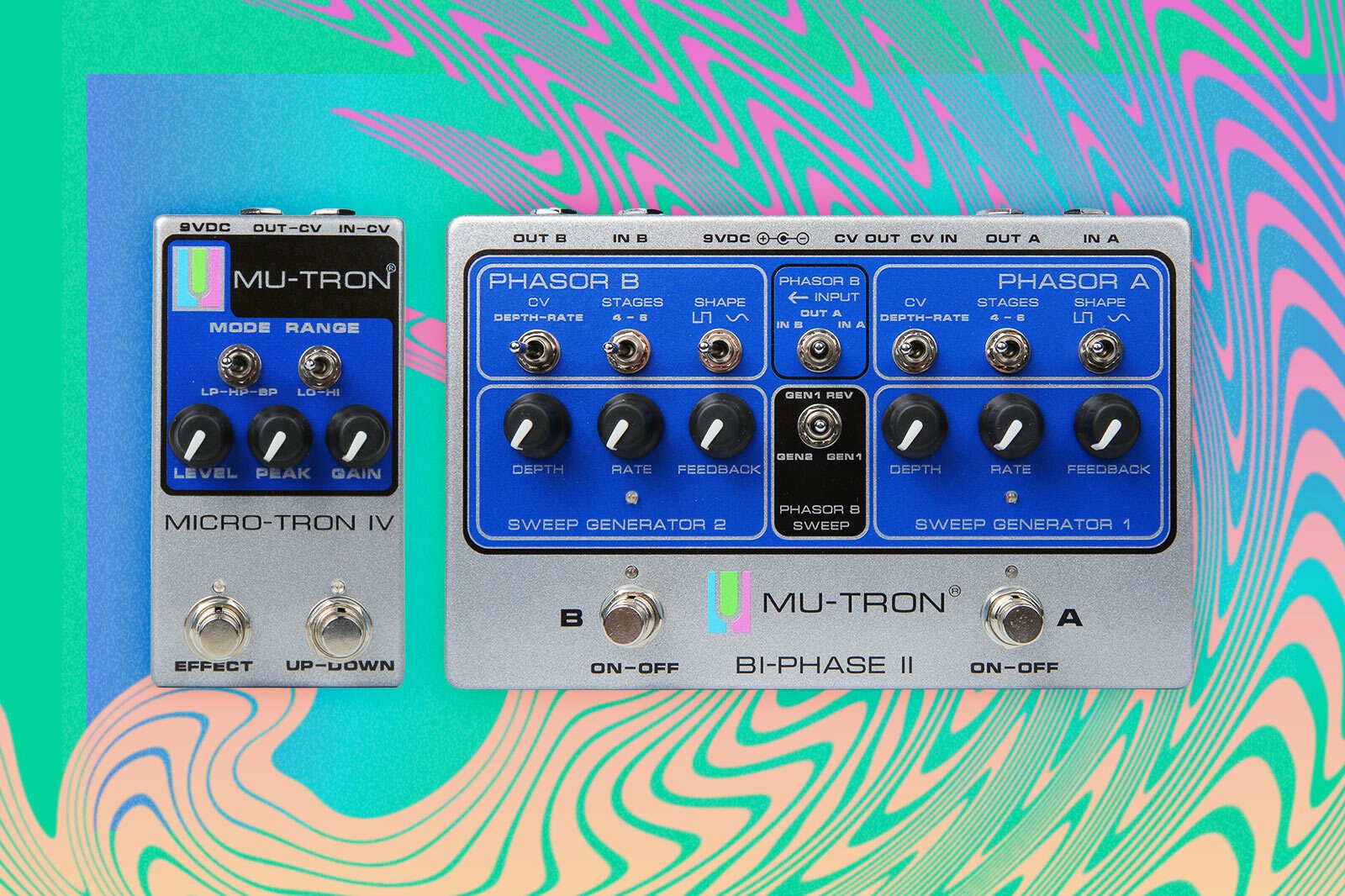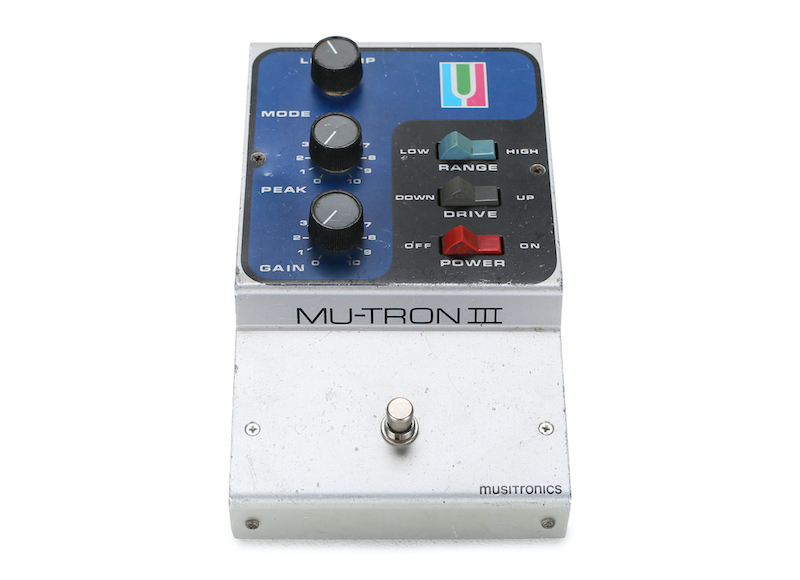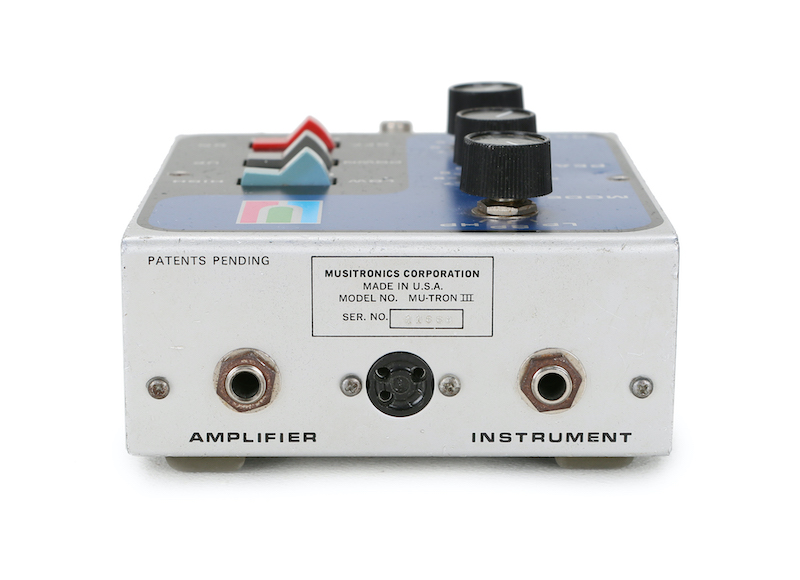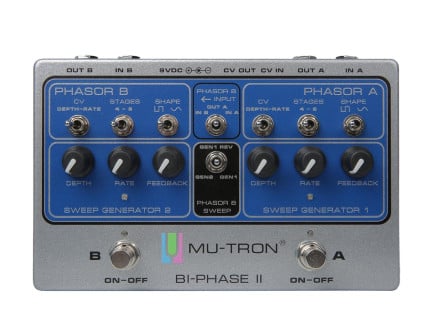Nurturing one another's innovation and creativity is a huge part in how we develop and expand upon art, from genres and styles to methods and techniques. These styles and techniques can be described by analyzing any number of their characteristics, from harmonic and rhythmic structure to tempo, form, or instrumentation—but only recently has recognition been given to the process of sound design and effect processing. Of course, in order to fully appreciate how some of today's best-loved music came to be, we must also recognize the pioneers who developed the essential tools that produced such brilliant music…including, of course, effects and sound shaping devices.
Several of the sounds found throughout the genres of the '70s and onward (e.g. funk, rock, soul, pop, and dub) owe a debt of gratitude to Musitronics (aka Mu-Tron) and the brilliant minds behind it: Mike Beigel and Aaron Newman. You know that classic "auto-wah" sound famed by artists like Stevie Wonder, the Grateful Dead, and Larry Coryell? Yeah, the Mu-Tron III is where that all came from. You know Lee "Scratch" Perry's swirling dub ambiences? Take a look at the Bi-Phase—and of course, the list goes on.
From their earliest days experimenting with combining synthesis and guitar effect processing to modernized, current-day reissues of their timeless classics, Mu-Tron to this day keeps a studio-quality, fully analog signal path through all their pedals, producing the natural and awe-inspiring sonic flavors we have come to love over the past several decades. Please join me in reviewing what a brilliant company Mu-Tron is, from its humble beginnings and collaborations to its current state in the pedal marketplace.
Rising like a Phoenix: An Overview of Mu-Tron's Past and Present
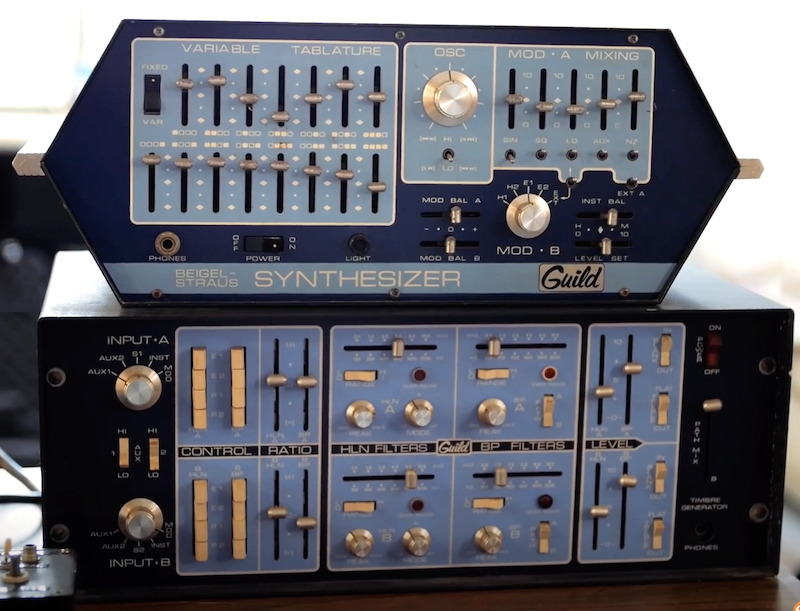 An early prototype of the Guild Beigel-Straus Synthesizer
An early prototype of the Guild Beigel-Straus Synthesizer
Finding his way through music and technology, Mike Beigel, one of the primary founders of Mu-Tron, pursued an education in electrical engineering at the Massachusetts Institute of Technology and not only achieved a dual B.S. but also graduated as MIT's first "Electronic Music" alumnus. After graduating in 1970, Beigel utilized his new-found knowledge and experience by entering music technology through the Guild Guitar Company as an engineer consultant. During his time at Guild, he and coworker Izzy Straus were prototyping synthesizers systems that featured classic synthesis techniques (include filtering, envelope following, and ring modulation), but when Al Dronge, the CEO of Guild Guitar Company, tragically passed in a plane crash, so too did the work of synthesis at Guild.
In 1972, with Guild Guitar Company moving in different directions, Beigel teamed up with Aaron Newman, Guild's head engineer, to pursue a small business in creating effects specifically for guitar players. Entering into a fairly-new and developing market that only started gaining traction in the late '60s, most manufacturers focused their efforts toward distortions, tremolo, and wah effects—this missing opportunity for innovative advanced modulation was Beigel and Newman's to take. Their aspirations leaned towards studio-quality effects for performers in a more compact design. Borrowing features from the groundwork laid by Beigel's synth prototypes, they were able to create brand new effects that focused heavily on bringing the brilliant sounds of synths to the popular and quickly expanding world of electric guitars. Thus, Musitronics was born into the world in Rosemont, NJ, and music was about to be a little more funky.
With a fully dismantled synthesizer waiting to be repurposed, Beigel and Newman arrived at the idea of creating an effect that utilized a state-variable filter with an envelope follower. With the combination of a few parts that would achieve loads of headroom and automated filter cutoff, the auto-wah was born in the form of the Mu-Tron III. This pedal not only established Mu-Tron's legacy in the pedal manufacturing community, but also developed a unique sonic tool that established many artists' and genres' tonal palette. Its success led them to dive further into phasers, octave division, and even collaborate with another renowned effect maker, Dan Armstrong (more on all of this later).
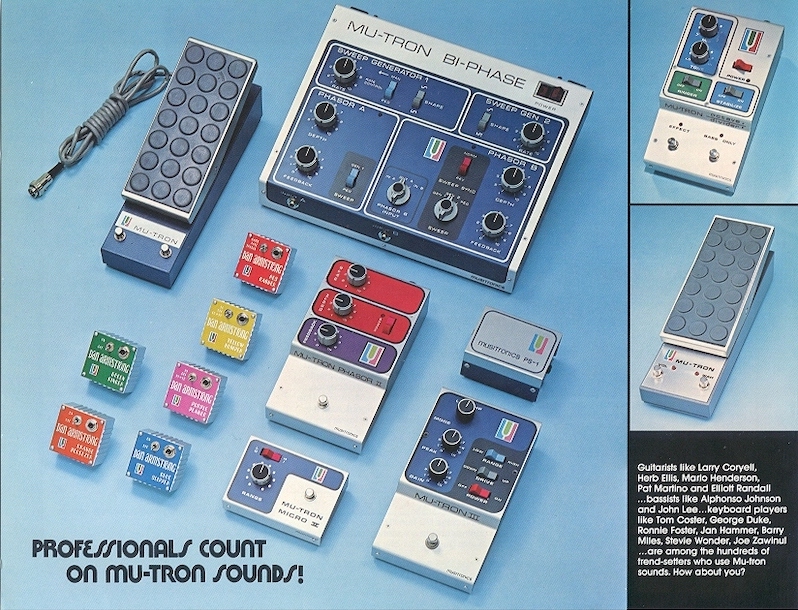
However great their impact was on music, the money wasn't there for them to continue creating at the quality they required. Unfortunately, their parts choices and a crashing economy eventually put them in a strained financial position. In order to try to recuperate and save themselves from bankruptcy, Mu-Tron was sold to the renowned synthesizer company ARP in 1978 based on a royalty collection agreement. Sadly, this ultimately saw no profit; ARP itself folded in 1979, taking Musitronics/Mu-Tron down with them and leaving Beigel and Newman only a side project called Gizmotronics. Gizmotronics suffered a similar fate, slowing to a halt after Newman's unfortunate passing from a heart attack. These events led Beigel to step back from music technology for quite some time—though he did have a hand in the 1995 production of Electro-Harmonix's Q-Tron and many of its successors.
In the early 2010s, Beigel noticed the high prices for Mu-Tron pedals on second-hand marketplaces, often priced well above their original cost, and thought to himself that he could bring back these amazing pedals with an even greater clarity for a much lower cost. In 2013, Beigel revived Mu-Tron in the form of Mu-FX, bringing with it many new iterations of their classic effects with some new additions. Today, they continue to produce newer models such as the Bi-Phase II, Boostron II, and Micro-Tron IV, equipped with modern day-functionality and a much more compact build—Beigel has reflected on how size factored into Mu-Tron's complications toward success, and seeing the market today move towards compact pedalboards seems to have clicked with him in his more recent builds.
Now that we have taken a high-level look at the overarching history of Mu-Tron in music technology and the pedal community, let's take a step back to dive into the evolution of their catalog. Looking at individual devices or collections of pedals one-by-one, we will see how certain products came to be—along with a detailed breakdown of their parameters, their impact on a wide range of music, and even how they carry into the current Mu-Tron lineup.
Mu-Tron III: A New Take on Wah
Distinctive by its original design and its simple yet performative timbre, the Mu-Tron III lives on throughout many pedals to this day. Being their first pedal inspired by the remains of their scrapped synthesizers, Mu-Tron III combined a state-variable filter and an envelope follower to create the now classic auto-wah sound heard throughout countless records. Not only did the preamp drive the signal enough to get a fantastic and dynamic amplitude and modulation range, but because Musitronics went for an atypical approach using a synthesizer filter (unlike the filtering methods found in wah pedals of the time), the Mu-Tron III featured three different filter types to choose from for a highly sculptable tool. Allowing low, band, and high pass filter types each with controllable resonance (via the peak control), the Mu-Tron III provided a plethora of squelchy and quacky sounds that are now beloved by many.
The envelope follower translated the guitar's amplitude shape as a way to sculpt how the cutoff frequency opens and closes, while the onboard controls offered a variety of settings for the filter as well as the preamp. You could switch which direction the envelope modulated the filter, making for classic burps and quacks as well as more gurgly backwards-feeling sounds—and with both envelope directions applicable to all three filter types, Mu-Tron III made it possible to achieve a huge range of sounds. This new and unique feature to the guitar realm was even more flexible thanks to the Gain control, applying that wonderful Mu-Drive preamp and consequently setting the sensitivity of the envelope follower. Not only was this a quite smooth and dynamic effect, but the Mu-Drive preamp's optocoupler design also provided fascinatingly low noise and would be implemented in several other effects to come.
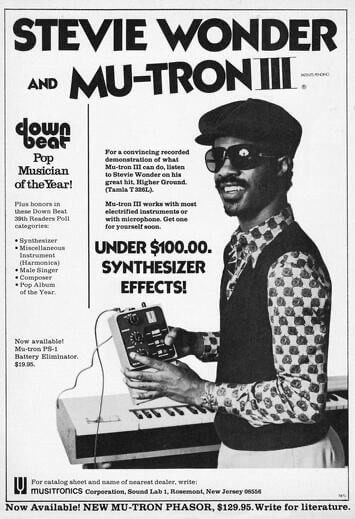
This design ideal of creating both studio-quality and performance-ready effects was Beigel and Newman's foundation, and no doubt contributed directly to the music inspired from such pedals. Some of the more famous inclusions of the Mu-Tron III can be heard on tracks like "Higher Ground" by Stevie Wonder, where he even posed for a photo shoot with the Mu-Tron III to help establish its recognition in the pop, R&B, and soul world. Along with its clear influence on the funk genre with the likes of Bootsy Collins in songs like "Bootzilla", you can also hear it appear in rock through the likes of Jerry Garcia in Grateful Dead tracks like "Estimated Prophet" and "Shakedown Street," each of which presents a vocal and slidy sound idiomatic to the Mu-Tron III.
Other iterations and prototypes came forth throughout Musitronics's life, including the improved Mu-Tron III+, the compact and solid-state Mu-Tron Micro V, and the Mu-Tron VII, which features more extensive control over the envelope, filter, sensitivity, and mix of the entire effect. Eventually, after Newman's death and the collapse of Musitronics, Beigel was contacted by his competitor and friend Mike Matthews of Electro-Harmonix. With Beigel's help, Electro-Harmonix produced a new iteration of the Mu-Tron III in the form of their very own Q-Tron, a similar setup with a psychedelic new look—unsurprising from the likes of EHX. Beigel assisted with many variations on the Q-Tron, but mostly stayed out of music tech until 2013 when he started up Mu-FX.
Mu-FX brought many continuations of the Mu-Tron III with the Tru-Tron 3X (which offered two types of boost), as well as the Micro-Tron III, which compacted the Mu-Tron III into a much more modern-day, pedalboard-friendly format. However, the most recent evolutions of this design include the Micro-Tron IV and the Ripper—each still available as of the writing of this article. The Micro-Tron IV is a faithful continuation that builds upon the compact Micro-Tron III by adding a control voltage (CV) input for expression control as well as a CV output for the envelope follower. These features expand its flexibility, adding more control over the pedal itself and throughout your pedalboard. For those who want a specific shape response with their Micro-Tron IV to act more in line with the original Mu-Tron III's optocoupler or even a snappier response for use with 16th and 32nd notes, Mu-Tron offers extra flavors through their Opto-Mod chipset…allowing you to customize your Micro-Tron IV to your liking.
Mu-Tron also makes the Ripper, a fantastic auto-wah that foregoes the optical design for a much lower power draw—without sacrificing fantastic tone.
Phasor and Bi-Phase: A Clean and Creamy Collaboration
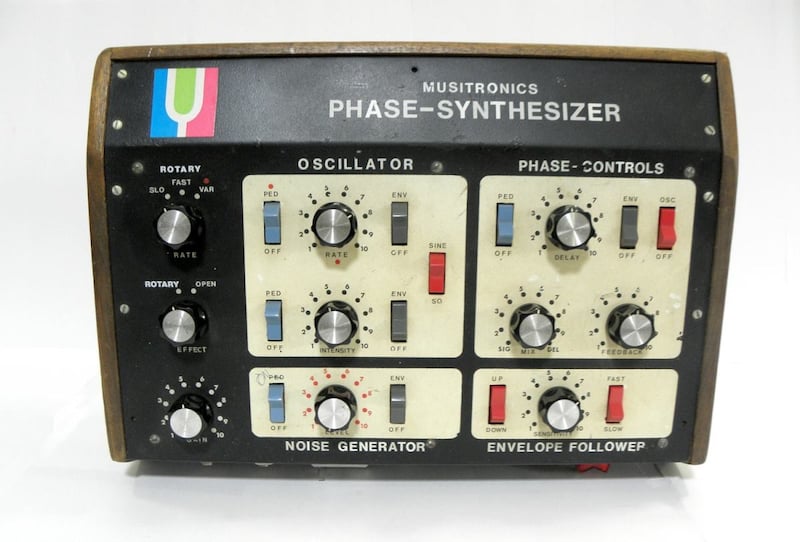 Mu-Tron's 1973 prototype Phase Synthesizer
Mu-Tron's 1973 prototype Phase Synthesizer
Perhaps starting with the classic uni-vibe effect, the '70s were filled with many variations on the phaser effect, and Musitronics wanted in on the game. The direction they were on was more akin to a flanger, as their 1973 prototype, the Phase-Synthesizer, utilized a bucket-brigade circuit (and, as noted in our recent article about the history of Eventide, the terms "phaser" and "flanger" were often conflated at this time). However, the features implemented in the Phase-Synthesizer—LFO, feedback, and pedal control—were the foundation of two Musitronics phasers that would go on to have massive success: the Phasor and Bi-Phase.
The 1974 release of the Phasor utilized an operational transconductance amplifier (OTA), a new integrated circuit which led to expanded dynamic range for intricate and clean phasing—a feature more in line with Beigel and Newman's vision for studio-quality effects than the favored FET circuits of the time. Originally designed around a four-stage routing, the Phasor's first iteration featured simple Depth and Rate controls for an easy-to-use and fantastic sounding effect; it wouldn't have a successor until after Newman's ingenious idea for a dual phaser.
Pondering the interplay that could come from two phasers with shared properties and multiple signal routing options, Newman dreamt up Musitronics' highly renowned Bi-Phase. Bi-Phase featured two independent phasers, each with a sweep generator (LFO), sine or square LFO shape, and a depth control. The two phasers' sweep generators could operate fully independently—but the second sweep generator could also sync to the first. Phasor B's input could come from one of three places, and a multitude of parameters could be controlled via an external pedal (inspired by the Phase Synthesizer).
The basis of the Bi-Phase involved a perhaps outdated photo-cell and lamp setup found in the original Shin-ei Uni-Vibe. But because of its attention to detail in the dynamic range department, the Bi-Phase initially lacked the character found in other FET-based phasers. After inviting their friend Bob Moog over to figure how they could improve the Bi-Phase, they found that adding a controllable feedback loop in the phasors made the effect considerably more pronounced while still achieving a fantastic dynamic range.
The creative possibilities from the Bi-Phase were quite expansive for the world of phase-shifting, but that number of features and controls came at a price—this thing was huge! While Musitronics was known for their larger pedals in the stompbox scene, the Bi-Phase was so large that it could be mounted to a microphone stand and performed with your hands—and with that much control, who could blame you? The original unit came with a dual footswitch controller that would engage each phaser, but like I mentioned previously, certain controls could be modulated via an expression pedal. Made specifically for the Bi-Phase, the Mu-Tron C-100 was a rugged and performable pedal and alternative for the footswitch, offering foot control over parameters such as sweep generator one's rate as well as one or both of the phasers' sweep controls in place of the generator.
With Musitronics being highly revered for their pristine and studio-like quality found throughout their pedals, the Bi-Phase got tons of love in the studio side of music, finding its use in rock, funk, dub, and much more. One influential character to mention is the famous Lee "Scratch" Perry, utilizing the Bi-Phase's unique and swirly textures for psychedelic dub atmospheres. You can hear it throughout many tracks on keys and guitar, and as a consequence of his ingenious and idiosyncratic recording techniques, he would often use the Bi-Phase as a performance tool during the recording process to give sounds an unheard of liveliness and character. It's also well worth mentioning Bi-Phase's inclusion throughout the famous Smashing Pumpkins album, Siamese Dream. Applied quite differently, the Bi-Phase gives lift and movement to so many elements heard throughout Siamese Dream—but it can be heard most prominently on cleaner guitar tracks and ambiences, providing a quite "dreamy" texture that counteracts the heavier distorted sections.
The fantastic sound and love for the Bi-Phase influenced the creation of the Phasor II, incorporating the same feedback loop parameter for creating pronounced sweeps. Many prototypes for newer phasers came about towards the end of Musitronics, including a Bi-Phase rackmount edition as well as another rackmount effect known as the E-Phasor—unfortunately, these wouldn't go on to prosper. Bi-Phase's influence has stretched even into the virtual realm, with Arturia making their own VST version to bring such wonderful wiggles to today's ever-growing producer community.
Today's Mu-Tron recognizes all the success of Musitronics originals, and honors them with the Phasor III and the Bi-Phase II. The Phasor III combines the brilliance of the Phasor and Phasor II for the best of both worlds—and in this case, that means options for either a four or six stage phaser! Naturally you have control over depth and rate of modulation with a feedback control for the six stage option, but Phasor III expands and modernizes a switchable modulation shape for square or sine wave as well as a CV in and thru port for modulating the depth or rate via any external control voltage source. The Bi-Phase II follows suit with the addition of CV in and thru, with selectable control per phaser. Happily, they've also minimized its footprint to a much more humble and modern pedalboard size. With the addition of the option for four or six stage phasing per phaser, the Bi-Phase sticks true to its roots in its controls and routing—making for a powerful tool for psychedelic guitar textures, seasick, swirling ambiences, growling synth bass lines, and much more.
Octave Divider: What Goes Up Must Come Down
Another one for the books would have to be Musitronics's ventures into layering octaves within the guitarist's tone—cue the Octave Divider. With Hendrix showcasing the brilliance of an octave-up effect courtesy of the famous Octavia pedal, Musitronics made an entrance for the first octave-down pedal to meet guitar players, introducing a completely original, analog circuit design to bring a more foundational and grounding tone. Many pitch shifting and octave pedals today utilize digital technology to achieve intriguing and complex polyphonic pitch shifting, but since Musitronics pre-dates digital stompboxes, you can be sure that the Octave Divider had a completely analog signal path that produced a warm and righteous tone to support any monophonic licks and play-styles.
Even with a simple set of controls and switches, time has told us of its amazing timbral characteristics. Engaging the effect, you could blend the original signal with the octave shift down as well as shape the tonal features of the suboctave—and for introducing grit, edge and a super-octave to your sound, the Octave Divider featured a "Ringer" switch to engage an octave-up effect—taken from their collaboration with Dan Armstrong (more on that later). The tones produced from the Octave Divider replicated the frequency and amplitude contours of your instrument, and for a stronger connection between the amplitude and pitch recognition there was a "stabilize" circuit that could be engaged based on need and timbral choice. Additionally, you could even engage the "Bass Only" footswitch to achieve baritone and bass guitar ranges while still replicating a similar formant quality.
Bringing back that familiar sound in two new variations, Mu-FX released two successors in their newer compact yet ever-powerful and clean design. Their original revival was known as the Octavider, giving you all the same control and functionality in a much more pedalboard-friendly format—and as of recently, they've rebranded the Octavider as the Octave Divider, restoring its original title. The second addition to their line up, the Octavider+, is a fantastic representation of how designers can improve upon something great without taking away any of the great character and foundation the product is based upon. The Octavider+ features the same mix & tone controls with a stabilize circuit, but new additions include the attenuated ringer circuit as well as a new pure fuzz circuit with an adjustable intensity. This new level of control equates to several more variations of tonal possibilities, and since the fuzz and octave effects are separately switchable, you could even just utilize Octavider+ as a Fuzz pedal—super versatile!
The Dan Armstrong Collection: London Meets Rosemont
Taking a step away from Mu-Tron for a second, we have to recognize the brilliant work of Dan Armstrong—and ultimately, how his work led to Mu-Tron. Armstrong was as talented at playing the guitar as he was crafting them, so much so that he built a unique and unmistakable translucent plexiglass design known as the Ampeg Dan Armstrong guitar. After leaving Ampeg in the early '70s, Dan went on to build a ton of fantastic miniature pedals in collaboration with an electrician named George Merriman—something they shared in common was how they were both American-born, but lived in London. Their work together led to the design of eight different pedals that added tone and character to any electric guitar and were capable of plugging straight into the instrument's output jack, making them like a module of the instrument itself.
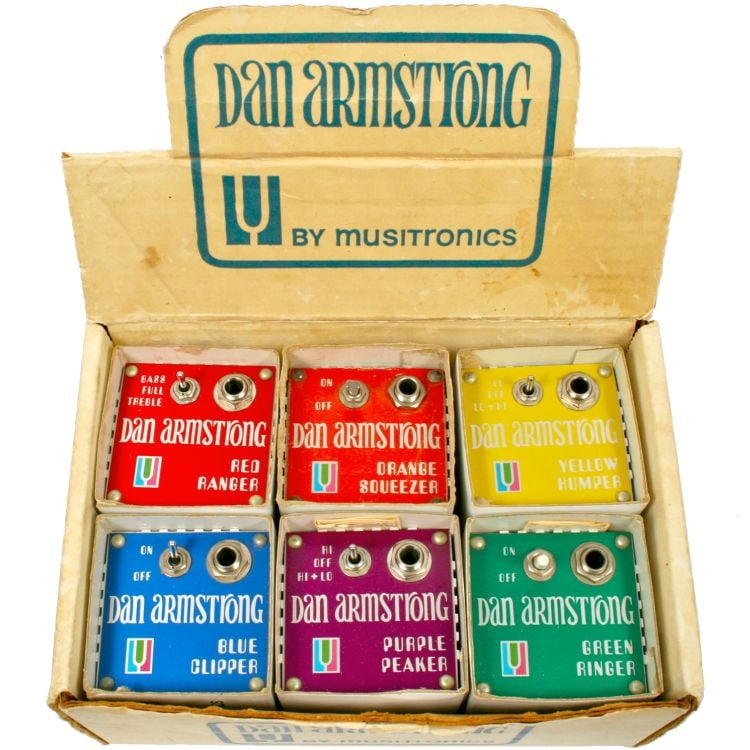
Needing help breaking into the US market, Armstrong and Merriman wound up making a deal with Musitronics for producing U.S. releases. Only interested in reissuing five of the original eight pedals, Beigel actually helped design an original pedal based off of the Dan Armstrong Orange Divider. Having already built an octave divider, they switched their attention back to the dynamic and gain-staging side of Armstrong's pedals to create what would be known as the Orange Squeezer, a compressor that chopped off the transients and brought up the body of the signal to make fat, sustained tones that would carry throughout your effects. Although plans were made to take these mini-pedals and make them into full-sized ones much like Mu-Tron's own product line, there was little funding on the Mu-Tron side of things, hindering production.
The collaborative collection seemed to favor dynamic effects as well as coloration tools to add timbral clarity and variance to your sound, including boosts, fuzzes, and the Orange Squeezer. Starting with the more tonal effects, Mu-Tron reissued a distortion pedal that could be pushed into gnarly fuzz territories known as the Blue Clipper as well as an octave up & fuzz tone known as the Green Ringer (which found its way into the Octave Divider, as mentioned earlier). Looking more at the spectrally shaping selection, Mu-Tron took on two peak boost pedals that focused on boosting in the low/low-mids and high-mids known as the Purple Peaker and Yellow Humper. The final addition to Musitronics's Dan Armstrong roster was the Red Ranger, a third boost pedal that offered over 20dB tilts in either the lows or highs or a 13dB boost to the entire signal, making for a very shapeable starting point.
When Mu-FX came to be, Beigel decided to continue the legacy of Armstrong effects by incorporating one of these classics into their newly designed Boostron II pedal. Integrating the Orange Squeezer, the Boostron II is a perfect combination of tonal and boosting effects for a lead-ready sound—Mu-FX looked towards the ProCo RAT and Alembic Stratoblaster as inspiration for the distortion and clean boost/preamp sections, respectively. Redesigned to fit their current aesthetic, the Boostron II removed the distortion section and expanded the preamp section by offering not only the original Mu-Tron III preamp, but also another Armstrong original with extra control for tilts: the Red Ranger. Combining these flavors with an adjustable Orange Squeezer makes the Boostron II a fantastic option for those looking for the classic guitar tones of the 70s, and much like the Octavider+, the Boostron II allows you to utilize either or both the compressor and boost sections.
More Flavors in the Pot: Various Attempts and Current Additions
Taking a look at the rest of their previous and current catalog, let's start with one of the final pedals that was created and sold during Musitronics life cycle: the Mu-Tron Flanger (image below, via Soundgas). Built off the earlier findings with the Phase-Synthesizer and Bi-Phase, the Mu-Tron Flanger provided a fantastic BBD-based effect with loads of controls for the time it was released. It featured LFO rate as well as start and stop delay time controls, as well as a feedback control for creating subtle to pronounced flanges. Engaging the Pedal footswitch flipped from automated sweeps to a manual control via the onboard pedal (a feature borrowed from the Bi-Phase). Unfortunately, this pedal was not in production for long and hasn't had a comeback since. The same is true of their C-200 Volume-Wah pedal based on the same foot pedal structure. Another prototype that never truly surfaced included a Oc-Tron Mk IV, which combined aspects of the Mu-Tron III and Octave Divider with unique controls for filtering and clipping, even keeping the ringer circuit involved.
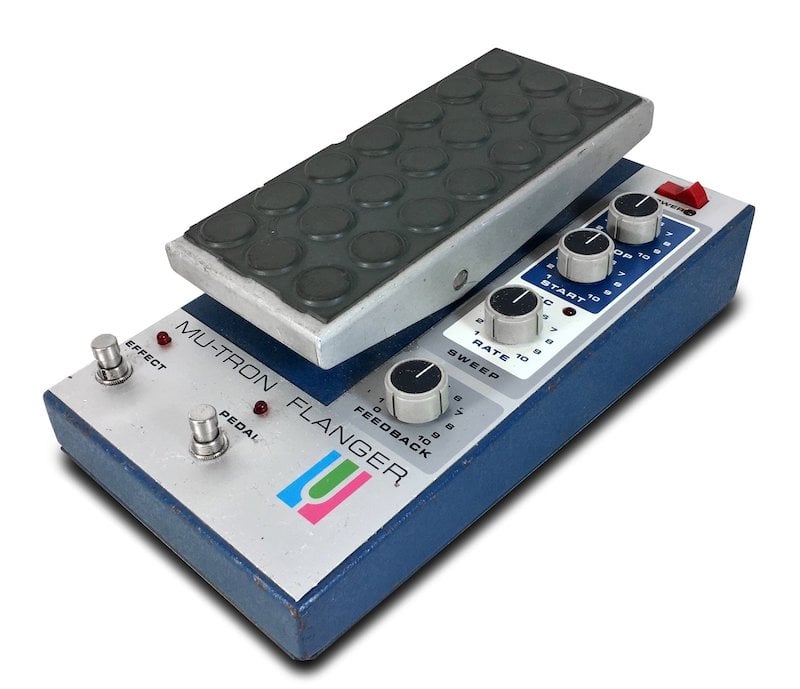
In the present day, Mu-Tron produces several classic effects with the same high-quality build and attention to detail found throughout their back catalog. Continuing their signature optical design, Tremu-Tron is a current addition that features the Mu-Drive—the Mu-Tron III preamp—going through a customizable tremolo. One of the cleanest tremolo pedals you'll ever hear, the Tremu-Tron features a Speed control for the LFO rate, a mixable LFO Wave control between sine and square, and a Blend control to determine how accentuated the effect is. Another fantastic pedal on their current lineup is the TubeTron, bringing a new flavor of saturation and gain to color your signals. Acting as a treble boost, the four controls feature a general Drive knob for adding grit to your signal while the two EQ controls, Treble and Middle, shape the highs as well as the lows+mids, respectively.
Wrapping Up with Some Final Thoughts
Finding a unique and purposeful goal isn't difficult. The trick is the follow-through and the drive to achieve your goals—and the ability to get back up after you fail. Across his long history in effect design, Beigel has had no issue with these concepts and even to this day carries out the legacy of a brilliant pedal company he started nearly 50 years ago. Even when times were tough and continuing his business wasn't possible, he came back with the same passion for creating quality pedals—each time bringing along all the things he had learned about the pedal community to make his designs more accessible without compromising fidelity. Take the Mu-Tron III (which went for $300 in its day) and compare it to the Micro-Tron IV: the new version provides greater flexibility with the same attention to detail in parts and quality. That is remarkable.

There's also something to be said about sticking to your roots rather than scrambling to meet the demands of today's marketplace. Mu-tron's love for sonic exploration continues to this day, maintaining their use of durable housings, optical technology, a completely analog signal flow, and studio-quality sound. It's easy to pump out mediocre-yet-adequate recreations of classic gear with plastic housings, digital chips, and generally cheaper parts…but it appears that Beigel and the rest of the Mu-Tron team understand that such compromise isn't the most honorable path forward, and isn't in keeping with their history of making rugged, world-class devices for sonic expression. All in all, it's remarkable and quite lucky that we live at a time when these effects are once again readily available and easy to attain—and as such, we at Perfect Circuit look forward to deepening our relationship with them.
A final note I'd like to mention is how amazing it is that these classic effects we use in a multitude of ways—be it analog outboard gear, DSP effects, or even virtual effects in your DAW—all came from the melding of synthesis with electric guitars. Effects I grew up using in my own electronic music productions that now might seem commonplace in that arena actually grew from curiosity in a non-synthesis related area. Keep curious.

